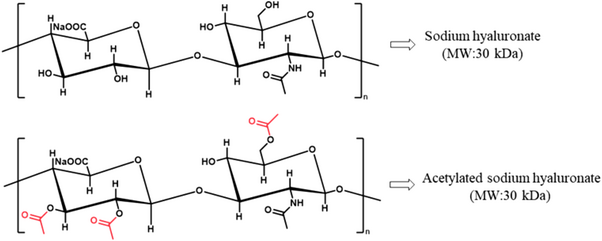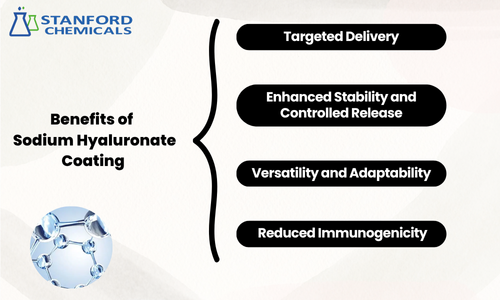Sodium Hyaluronate Coating for Drug Delivery
Sodium hyaluronate (HA), the sodium salt of hyaluronic acid, has been a very versatile biomaterial in drug delivery applications.
Why is Sodium Hyaluronate Used in Drug Delivery
This is mainly attributed to its distinctive physicochemical and biological properties.
Sodium hyaluronate is a linear polysaccharide containing repeating disaccharide units, which contains lots of carboxyl groups (-COOH) and hydroxyl groups (-OH). Its structure renders it highly hydrophilic. It is water-soluble and can make very viscous solutions, which suits hydrophilic drug loading. Besides, its carboxyl groups and hydroxyl groups can be chemically modified to conjugate drug molecules or functional groups to construct intelligent delivery systems. The common modification methods involve esterification, amidation, and crosslinking.
Fig 1. The structures of sodium hyaluronate and its acetylated derivatives modified by esterification[1]
The structure of sodium hyaluronate provides the basis for drug delivery, while its biological properties are the key to the choice.
Hyaluronic acid is a natural ligand for CD44 receptor, which is highly expressed on most tumor cells, inflammatory tissues, and stem cells. HA-modified drug delivery systems are able to actively target these diseased tissues, enhancing local drug concentrations. CD44 is like a signal beacon, guiding HA to the locations of disease. Once the HA-coated drug reaches the target, it must be released in order to function. This is where the next key player enters: hyaluronidase. This enzyme degrades HA and, conveniently, is highly active in tumor or inflamed tissue. In the presence of hyaluronidase, the HA carrier degrades, releasing the therapeutic payload.
Hyaluronic Acid or Sodium Hyaluronate?
In the application of drug delivery systems, sodium hyaluronate is utilized instead of hyaluronic acid. Because the sodium salt form is more stable and more soluble in water at neutral or alkaline pH.
What Value Does Sodium Hyaluronate Coating Offer for Drug Delivery
- Targeted Delivery
Shell drug carriers with HA enable selective binding to such receptors, enabling targeted delivery of the drugs to the disease cells or tissues. For example, HA-coated nanoparticles can deliver chemotherapy drugs specifically to tumor cells with less damage to healthy tissues and fewer side effects.
- Enhanced Stability and Controlled Release
Sodium hyaluronate coatings protect encapsulated drugs from premature degradation and stabilize delivery systems. The viscoelastic formation of solutions by HA and the mucoadhesive properties enable sustained, controlled drug delivery with extended preservation of therapeutic levels at target sites. For instance, HA has been used to prepare sustained-release protein and peptide formulations, where traditional carriers like PLGA can cause inflammation and protein denaturation.
- Versatility and Adaptability
Sodium hyaluronate coatings are biocompatible with multiple drug carriers, ranging from nanoparticles and liposomes to micelles. It is chemically tunable and may be conjugated with various therapeutic molecules such as small-molecule drugs, proteins, and nucleic acids. HA coatings may also be made responsive towards specific stimulants (e.g., pH or temperature stimuli), enabling controlled drug release at targeted locations.
- Reduced Immunogenicity
As a naturally occurring substance in the human body, HA is biocompatible. It is less likely to trigger immune responses than synthetic materials. Sodium hyaluronate-coated nanoparticles are least familiar and recognized by the immune system, enhancing their shelf life and stability in the blood circulation for better target delivery.
Applications of Sodium Hyaluronate Coating in Drug Delivery
- Cancer treatment: Targeted drug delivery of chemotherapy drugs to cancer cells while minimizing systemic toxicity.
- Ocular drug delivery: Increasing the residence time and bioavailability of drugs in the eye for conditions such as glaucoma and dry eyes.
- Wound healing: Encouraging tissue repair and regeneration by delivering growth factors and other biomacromolecules to the injured area.
- Inflammatory arthritis treatment: Inflamed joint delivery of anti-inflammatory agents to alleviate inflammation and pain.
- Gene therapy: Enhancing the delivery efficiency and stability of gene vectors for targeted gene expression or silencing.
- Transdermal drug delivery: Enabling drug penetration through the skin for local and systemic delivery.
Conclusion
Sodium hyaluronate coatings are a powerful instrument in modern drug delivery that combines natural targeting functions with designed specificity. Employing HA’s inherent physicochemical properties and biological interactions, researchers can design systems to maximize therapeutic benefit while minimizing side effects. For more information, please check Stanford Chemicals Company (SCC).
[1] Chen, Fan & Guo, Xueping & Wu, Yue. (2023). Skin antiaging effects of a multiple mechanisms hyaluronan complex. Skin Research and Technology. 29. 10.1111/srt.13350.


